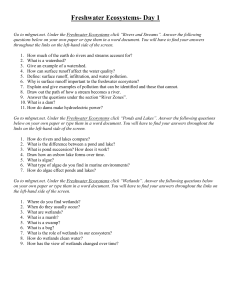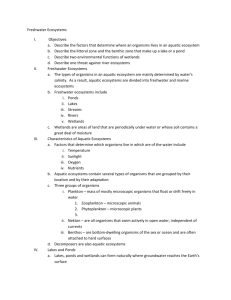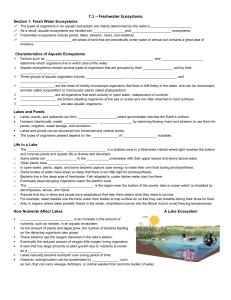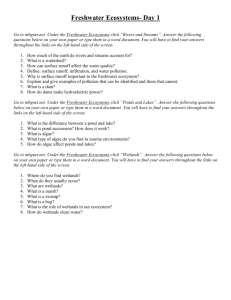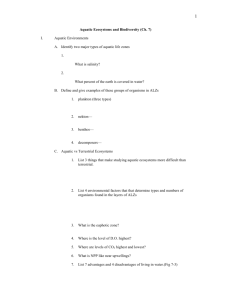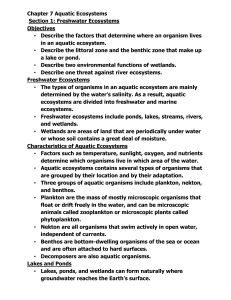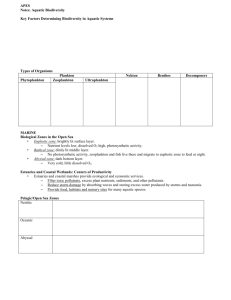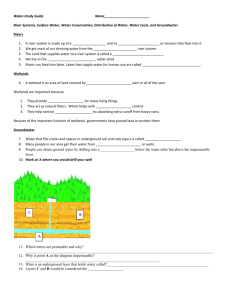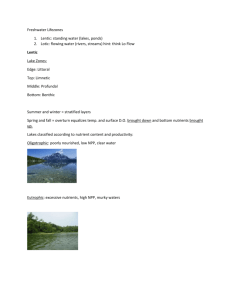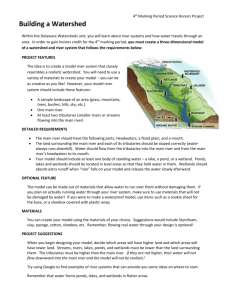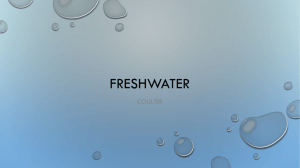Name Freshwater Ecosystems – Chapter 7, Part I Environmental
advertisement
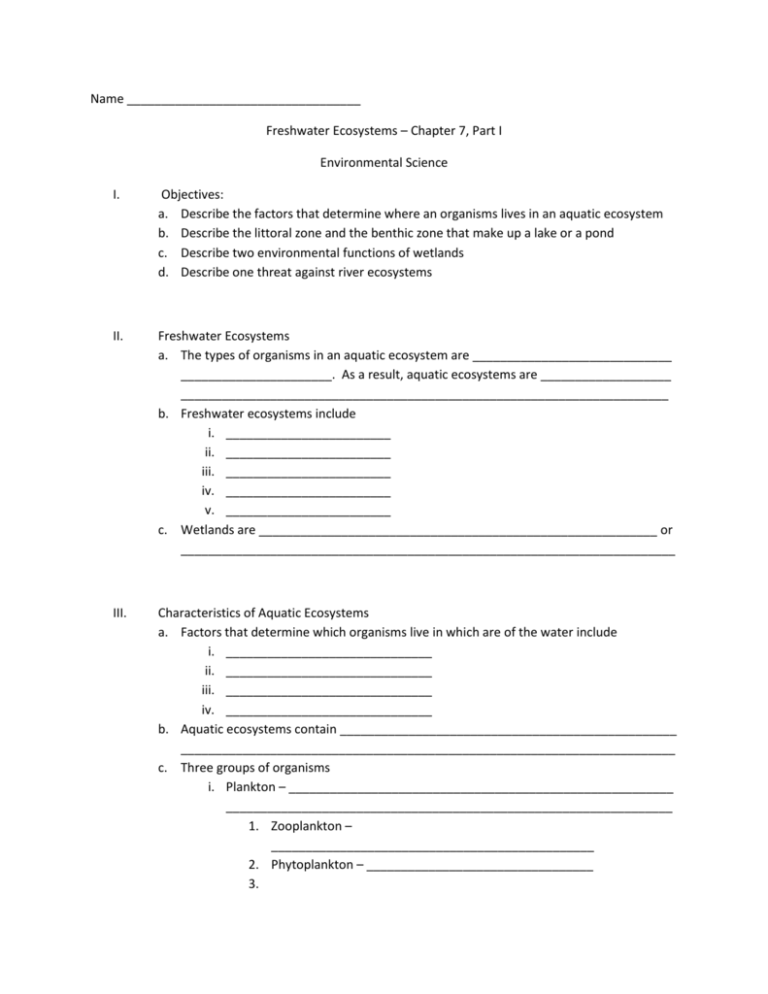
Name __________________________________ Freshwater Ecosystems – Chapter 7, Part I Environmental Science I. Objectives: a. Describe the factors that determine where an organisms lives in an aquatic ecosystem b. Describe the littoral zone and the benthic zone that make up a lake or a pond c. Describe two environmental functions of wetlands d. Describe one threat against river ecosystems II. Freshwater Ecosystems a. The types of organisms in an aquatic ecosystem are _____________________________ ______________________. As a result, aquatic ecosystems are ___________________ _______________________________________________________________________ b. Freshwater ecosystems include i. ________________________ ii. ________________________ iii. ________________________ iv. ________________________ v. ________________________ c. Wetlands are __________________________________________________________ or ________________________________________________________________________ III. Characteristics of Aquatic Ecosystems a. Factors that determine which organisms live in which are of the water include i. ______________________________ ii. ______________________________ iii. ______________________________ iv. ______________________________ b. Aquatic ecosystems contain _________________________________________________ ________________________________________________________________________ c. Three groups of organisms i. Plankton – ________________________________________________________ _________________________________________________________________ 1. Zooplankton – _______________________________________________ 2. Phytoplankton – _________________________________ 3. IV. ii. Nekton – ___________________________________________________ in open water, independent of currents iii. Benthos – ______________________________________________ of the sea or ocean and are _____________________________________________________ d. Decomposers are also _____________________________________________________ Lakes and Ponds a. Lakes, ponds and wetlands can form __________________________________________ ________________________________________________________________________ b. Humans intentionally create ________________________________________________ and streams to use them for ________________________________________________ c. Lakes and ponds can be structured into _______________________________________. The types of organisms present ______________________________________________ d. Life in a Lake i. The littoral zone is a ___________________________________________ where light reaches the ___________________________________ and aquatic life is _________________________________________________________________ ii. Some plants are ____________________________________________________ _________________________________________________________________. iii. Other plants have __________________________________________________ iv. In open water, plants, algae and some bacteria __________________________ _________________________________________________________________ photosynthesis v. Some bodies of fresh water have areas _________________________________ _________________________________________________________________ vi. Bacteria live in the _____________________________________________. Fish adapted to _______________________________________________________. vii. Eventually, ________________________________________________________ reach the benthic zone viii. The benthic zone is the region ________________________________________ which is __________________________________________________________ _________________________________________________________________ ix. Animals that live in lakes and ponds have _______________________________ _________________________________________________________________ 1. Examples – Water beetles use the hairs under their bodies to trap __________________________________________________________ __________________________________________________________ 2. In regions where lakes partially freeze in the winter, _______________ __________________________________________________________ __________________________________________________________ e. How Nutrients affect lakes i. Eutrophication is an ________________________________________________, such as nitrates, in an aquatic ecosystem ii. As the amount of plants and algae grow, the ____________________________ _________________________________________________________________ iii. These bacteria use the ______________________________________________. Eventually the _____________________________________________________ _________________________________________________________________ iv. A lake that has large amounts of plant growth ___________________________ _________________________________________________________________ v. Lakes naturally ____________________________________________________ vi. However, eutrophication can be accelerated by __________________________ _________________________________________________________________ into bodies of water V. Freshwater Wetlands a. Wetlands perform several important environmental _____________________________ b. Wetlands act like _________________________________________________________ ___________________________________________________________ from the water c. They control flooding by ___________________________________________________ d. These areas provide a home for _____________________________________________ in addition to ____________________________________________________________ ________________________________________________________________________ e. Environmental Functions of Wetlands i. _____________________________________________, nutrients and pollutants, which keep these materials from entering lakes, reservoirs and oceans ii. ______________________________________________________________, roads, buildings and human health and safety iii. ______________________________________________________________ iv. _____________________________________________________________ for commercially important fish and shellfish v. _________________________________________________________________ plants and animals vi. _____________________________________________________ for activities such as fishing, bird-watching, hiking, canoeing, photography, and painting f. Marshes i. Freshwater marshes tend to occur on __________________________________ _________________________________________________________________ ii. In shallow water, plants root _________________________________________ while their leaves ______________________________________________ of the water year-round iii. There are several kinds of marshes 1. _______________________________________ 2. _______________________________________ 3. _______________________________________ iv. Benthic zone – ___________________________________________, numerous types of decomposers and scavengers v. Water fowl (ducks) – adaptations such as _______________________________ _________________________________________________________________ vi. Water Birds (herons etc). – adaptations such as _________________________ ________________________________________________________________ vii. Marshes also attract ________________________________________________ _________________________________________________________________ g. Swamps i. Occur on _____________________________________, often near streams ii. Dominated by __________________________________________________ iii. Are ideal habitat for _____________________________________________ iv. Birds are attracted to ____________________________________________ v. Reptiles are the ______________________________________, eating almost all other animals h. Human Impact on Wetlands i. Wetlands were previously considered to be _____________________________ _________________________________________________________________ ii. As a result, _______________________________________________ for farms or residential and commercial development iii. The importance of wetlands is now recognized, as the law and federal government ______________________________________________________ _________________________________________________ of certain wetlands VI. Rivers a. At its headwaters, a river is ____________________________________________ and _____________________________________________________________________ b. As a river flows down a mountain, it may ____________________________________ ______________________________________________________________________ c. A river changes __________________________ and the ____________________ through which it flows d. In and near the headwater, mosses _______________________________ to rocks by using rootlike structures called _______________________________. e. Trout and minnows are __________________________________________________ f. Farther downstream, ___________________________________________________ i. Plants here can set _______________________________________, and the plants leaves vary in ___________________________________________ of the rivers current ii. Fish such as _______________________________________ also live in these calmer waters g. Rivers in Danger i. Industries use _____________________________________________________ ________________________________________________________for wastes ii. People have used rivers to __________________________________________ iii. These practices have ___________________________________, which have killed river ________________________________________________________ iv. Runoff from the land puts ______________________________________- into rivers and ________________________________________________________
